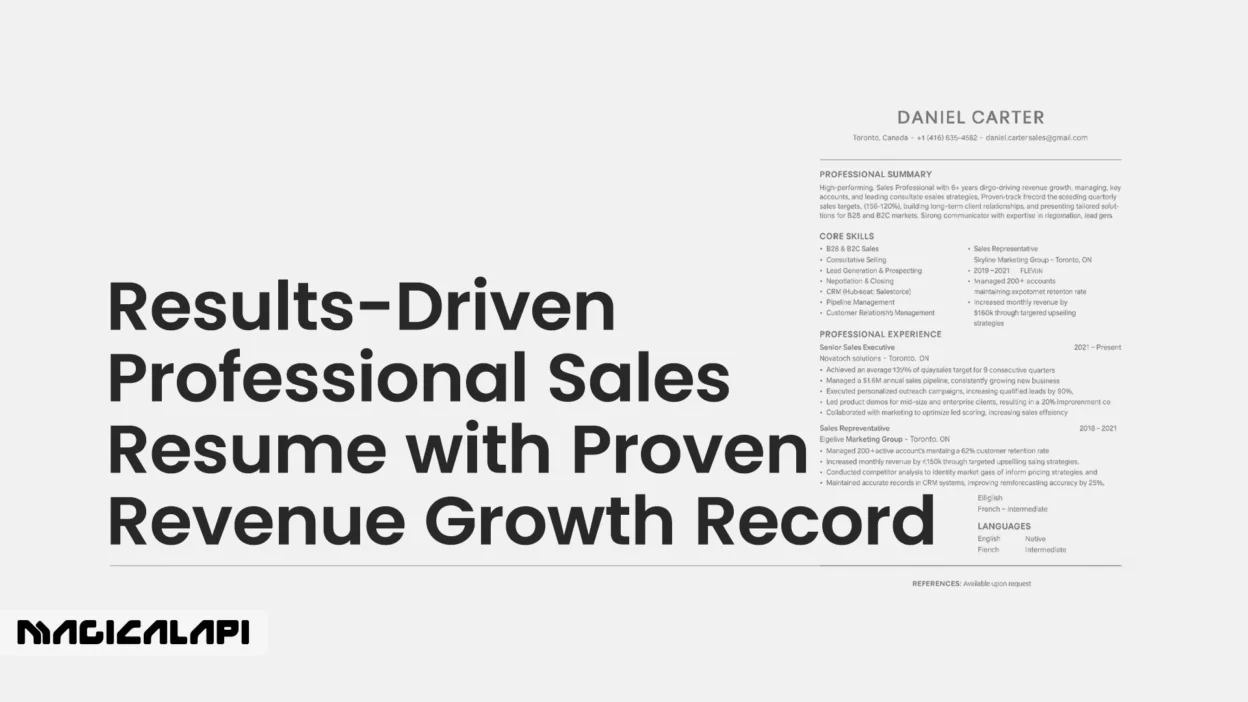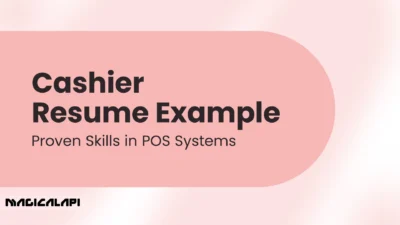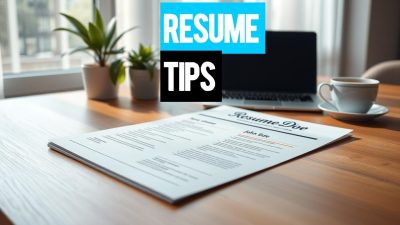Getting a great sales job can be a lot like a competitive sport, and your best sales pitch is not a product or service but you. Your sales resume is probably the most important file in your professional toolbox, yet too many professionals confuse it with simply a job description or history. Sales talent recruiters and hiring managers really want to know not only what you did but how much money you made at your previous company and how you would plan on doing it with them.
With commissioned roles and KPI’s on the line, your resume needs to act less like a traditional document and more like a pretty detailed financial report that exemplifies an indisputable ROI.
With that in mind, this guide is designed to help you walk through the exact steps to transform your CV from a passive job history to an aggressive, results-focused marketing tool that secures the interview and supports your proven history of revenue growth. If you take your career seriously, you must learn to write a sales resume that quantifies your accomplishments.
Table of Contents
What Makes a Sales Resume Stand Out?
The key to a good sales resume is simple: you must transition from responsibilities to achievements. A typical bullet point might say, “Responsible for managing a book of business mapping to mid-market accounts.” This is a responsibility. A great, results-oriented bullet point says, “Developed and managed a $4.5 million book of business (mid-market) increasing total customer lifetime value by 35% YoY.” This is an achievement in the form of a measurable result.
What distinguishes a true sales resume is that a recruiter can, in moments, see quantifiable evidence of your achievement. Recruiters will spend precious seconds scanning your resume, sometimes using ATS filters before human attention comes into play.
To be visible on-screen and in an ATS, you must be bold and utilize the metrics that best represent achievement for sales: quota attainment, revenue attainment, customer retention, and sales cycle efficiency. A resume is not a place for “I think I am good at this…” A resume is your opportunity to demonstrate commercial value. Each claim related to a skill or responsibility cannot simply be “please trust me”; it is your job to support every claim using understandable proof points or metrics.
Take the next step: create a cashier resume that highlights your strengths and gets you noticed.
Quantifying Your Success: The CAR Method for Revenue Growth
One of the most effective strategies to implement in your resume writing toolbox is quantification—often done with the CAR (Challenge, Action, Result) method. Sales managers seek candidates who not only solve problems, but get results that can be measured. The CAR method guarantees that your bullet points are results-driven and demonstrative of evidence-based metrics. Challenge: Give a concise description of the challenge or goal you faced.
(Whether it is low penetration in a target market; or you had to grow your average deal size.) Action: You will want to write the specific actions you took to overcome the challenge or reach the goal (including some high action verbs). (Trust me – I have never seen a sales manager question the existence of efforts once they have read your bullet for ‘implemented a new strategic partnership framework.’ Or, ‘first in North America to pioneer a multi-touch digital outreach sequence.’)
Result: Outline the resulting measurable positive outcome, with emphasis on Record of Proven Revenue Growth Record (Whether you achieved x, y or z – and the last few bullets should relate back to that record). (The result was a 50% increase in market penetration and $1.2M in new pipeline created.).
Result: Describe the measurable, positive outcome, highlighting your Proven Revenue Growth Record. (Example: Resulting in a 50% increase in market penetration and $1.2 million in pipeline creation.)
Here’s how to use this:
Instead of: Negotiated contracts with new clients.
Write: Negotiated and closed 48 complex enterprise contracts (average value $75,000), exceeding the annual quota by 18% and generating $3.6 million in ARR in FY2023.
By giving this context, you can help the hiring manager to quickly see the ability and impact of your work. When there are no exact figures, use an extreme or range (for example, “Managed a portfolio of 50+ clients”), but again, aim for the exact number.
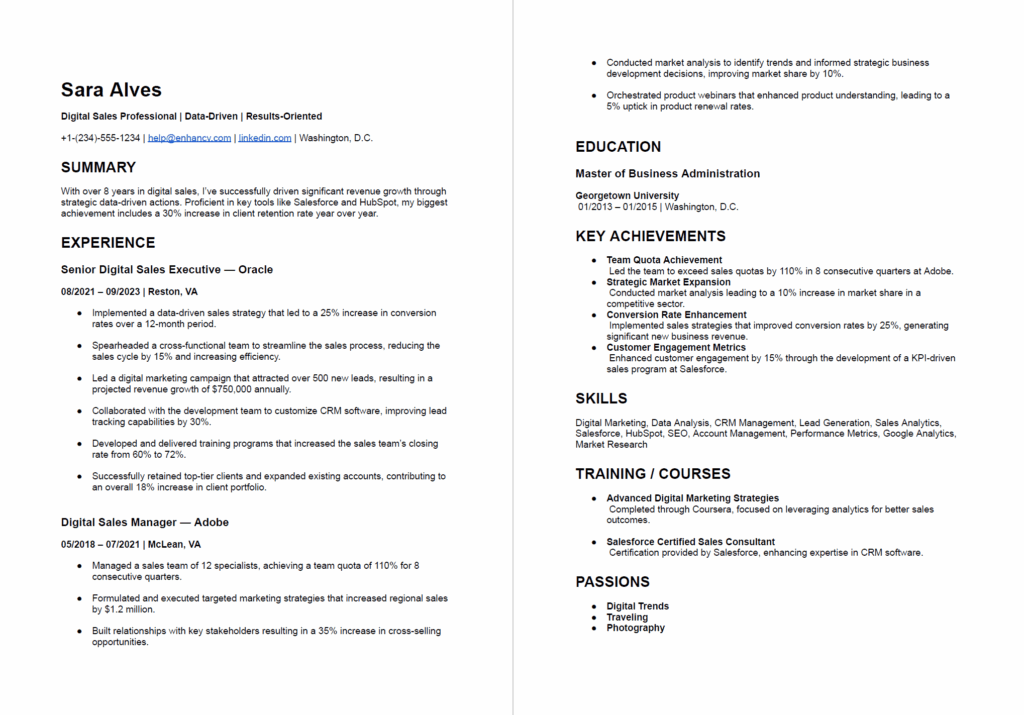
Key Skills for Sales Resume
A successful sales professional incorporates strategic thinking (soft skills) with essential technical skills (hard skills). While you will want a separate section specifically listing your skills for ATS purposes, explicitly showing these skillsets under your experience is also important, as it will demonstrate you possess the relevant knowledge.
Hard Skills (Technical & Operational):
- CRM Experience: List the various specific systems you have experience in, like Salesforce (specifically Sales Cloud, CPQ), HubSpot, Zoho, or Pipedrive.
- Sales Enablement: List the tools you have used like Gong, Outreach, SalesLoft, or sales enablement methodologies.
- Data Analysis: Or forecasting, segmentation, Excel/SQL knowledge.
- Knowledge of the Field: There are a number of areas and methods but can be categorized as: SaaS, B2B Enterprise, Consultative Selling process, MEDDIC/BANT methodology, etc.
Soft Skills (Interpersonal & Strategic):
- Negotiation & Persuasion
- Active Listening
- Relationship Management (Acquisition & Retention)
- Strategic Planning & Territory Management
- Resiliency & Objection Handling (or overcoming objections)
As you note, it is important to indicate your experience with these skills. Rather than just saying “Negotiation Skills” for example, you would write, “Employing advanced negotiation skills, I secured and managed a renewal rate of 92% across Tier 1 accounts for a value of $700,000 in recurring annual revenue.” Using both methods is the most impactful; it will help make you visible in an ATS yet provide the context and leverage for the recruiters you engage with.
Crafting Your High-Impact Sales Resume Summary
Think of the professional summary as the B2B marketing elevator pitch of your sales resume. This concise, powerful paragraph (or set of 3-4 bullet points) is at the top of your sales resume and is your career summary. In a world where hiring teams have short attention spans, the paragraph or bullet points must answer right away the big question of Why should I interview this person?
As an experienced sales professional, your summary should focus on total years of experience, top accomplishments (and quantified), and areas of specialization (e.g., B2B, SaaS, Enterprise).
As a professional in transition or someone with less experience early in your career, an objective statement is more appropriate (Objective statements can highlight transferable skills and enthusiasm for the growth that lies ahead). When deciding How to Choose the Right Resume Title or summary, align the heading or summary title with the job description you are currently targeting.
Many modern candidates rely on technology benefits using AI Resume Summary Generators to write this summary section, a simple way to condense years of experience into impactful, keyword-driven sentences. Use caution however to ensure the authenticity and quantification of your claim upon review of the technological completion. Again, this summary section must set a highly professional, results-oriented tone from first glance.

How to Structure Your Sales Resume for ATS Success
For nearly all large companies and many smaller companies, the Applicant Tracking System (ATS) serves as the gatekeeper. These systems will parse your document looking for certain Keywords for Resume and basic formatting. If you don’t modify your resume to pass ATS, it my never be seen by another person.
You can optimize your resume for ATS in a few simple ways:
- Format Simplicity: Use a clean, standard, reverse-chronological format. Avoid complicated graphics, tables, headers and footers, and different fonts that might bog down a parser. Use standard section titles (for example, “Professional Experience”, “Skills”, “Education”).
- Keyword Density: Make sure you review the job description and use specific words–product names, methodologies (for example MEDDIC, Challenger Sale), or specific technical skills–that are in the language of your own professional summary of experience bullet points, but in a subtle and general way.
- Type of File: Whenever possible, save and submit your resume as a PDF unless, in the case of an application, it specifically asks for a Word Document. PDFs will hold formatting.
- Length: The rule of thumb is always, two pages is ok for a senior sales professional with 10+ years of commercial experience, but it is always been best to keep it shorter. For a resume, ration and eliminate experience prior to the last five to seven years that is relevant and reflects your ability to produce results.
Before submitting any application, it is best practice to utilize a comprehensive Resume Checker tool, and check your document for grammar and formatting that would cause ATS parsing problems.
Magical Resume Checker
Discover the full potential of the Magical Resume Checker and explore the various options available to enhance your resume, optimize it for applicant tracking systems (ATS), and improve your chances of landing your dream job.
Leveraging AI: Use MagicalAPI Resume Checker for ATS Success
In today’s digital job market, you want every edge you can find to successfully pass the ATS and get a request for an interview with the hiring manager! This is exactly where AI-enabled tools will help you. MagicalAPI plays an AI advantage in data insights and careers. MagicalAPI essentially helps job seekers stand out.
The site has “Magical Resume Services” which include an effective resume parser, and a resume score – both are very useful tools. Again, the resume score will be of particular interest to persons in sales, as the score gives you an objective and data-based assessment of your resume effectiveness. The score will quickly help you find answers to:
- ATS Compliance: will your format at least pass a scan?
- Keywording: are you using the complete terms used in your industry?
- Content Gap: Are you emphasizing enough quantifiable results and achievements?
Finally, by using MagicalAPI tools personally and during your final review process, you are effectively receiving a pre-scan by an AI-based system that generally recruiter’s ATS use. That means, your resume not only looks professional, it is process-ready and technically sound in the event it is received.
These customized service tools will add to your document styling, as well as better evaluate a statement, so you have confidence in your background of revenue increases being visible in the document.
Top Sales Resume Templates: Choosing the Right Format
Though a functional sales resume template (which focuses on skills instead of chronology) may look the best for those candidates that have employment gaps or career changes, the overwhelming majority of recruiters and ATS systems prefer to see the Reverse-Chronological Format.
- Reverse-Chronological: This is the industry standard. It promotes the growth of your career showing the most recent and relevant experience first. This format is important for showing consistent success and growth in revenue attainment over time.
- Combination/Hybrid: This format begins with a strong professional summary (or “Skills Profile”) then has the traditional chronological work experience section. This is often the best choice for a more experienced sales professional because they can lead with the most impressive metrics and details about their careers.
Stay away from overly flashy, or decorative templates. Clean, modern templates with professional font choices (Arial, Calibri, or Garamond) and white space is ideal for readability for both the human eye, as well as the ATS.
Entry-Level Sales Resume Template Example
When presenting entry-level sales resume examples, the priority shifts from a long history of results to displaying potential and transferable skills. The candidate may not have years of quota attainment, but they can demonstrate they have the fundamental traits of successful sales professionals: hustle, persistence, communication skills, and basic business skills.
Core Focus Areas for Entry-Level:
- Highlighting accomplishments or achievements: You do not need to reference revenue numbers from your professional career. You should quantify accomplishments not just from work experience, but also experiences from school (e.g., “Led team of five as capstone project, achieving the highest ROI of 20 competing teams”), internships, or volunteer work to demonstrate value. Even part-time work experience could help: “Consistently exceeded upselling goals by 20% in a retail environment and ended my three-month tenure with ‘Top Associate’ status.
- Relevant coursework: List specific courses taken either in college or professional certifications relevant to sales strategy and/or form of market analysis (HubSpot inbound sales certifications for example).
- Transferable skills: Emphasize communication skills, negotiation skills (informally), and time management skills.
This style of resume will typically lay out neatly on one page and use a customized, focused objective statement that identifies your career goals and alignment with the company’s mission.
Magical Resume Score
Discover everything you need to know about Magical Resume Score , how it evaluates your resume, and the various options available to enhance your job application and improve your chances of success.
Senior Sales Resume Template Example
A senior sales professional’s resume targeting VP of Sales, Sales Director, or Enterprise Account Executive roles must tell a story of strategic leadership and significant financial impact. Typically, this resume is two pages and focuses on P&L responsibility, team management, and long-term strategic view.
Critical Areas of Focus for Senior Leaders:
- Executive Summary: Should begin with an impactful, quantifiable summary demonstrating accomplishments throughout their career (for example, “$50M in cumulative revenue generated over a 15-year career”).
- Strategic Leadership: Should include a summary of how you built, mentored, and scaled sales teams and quantifiable performance (for example, “recruited and on-boarded a 30-person Enterprise team who achieved 115% of the annual target, generating $15M in new business”).
- Global/Market Impact: Should include strategic initiatives and market penetration achievements (for example, “led a successful launch into APAC, establishing key partnerships and capturing 10% market share within 18 months”).
- Long-Term Retention: Should include retention rates, reduction in churn rates, and long-term contracts.
Finally, the work experience section should focus on the most impactful achievements of the last ten years, placing like metrics together to identify achievements of sustained excellence.
Action Verbs and High-Value Keywords That Convert
The language you use on your sales resume is the difference between being perceived as a manager of tasks and a creator of value. Strong action verbs are essential for immediately conveying impact and showing ownership of results.
Use powerful action verbs that are highly relevant to sales outcomes:
- Accelerated
- Generated
- Negotiated
- Secured
- Exceeded
- Spearheaded
- Cultivated
- Closed
- Pioneered
Beyond action verbs, ensure you are embedding high-value industry terms—the Keywords for Resume that recruiters search for. These might include:
- Sales Cycle Optimization
- Client Lifecycle Management
- SaaS ARR/MRR
- B2B/B2C/GTM Strategy
- Account Penetration
- Revenue Forecasting
- CRM Implementation
If you are struggling to write bullet points that sound dynamic and result-focused, dedicate time to reflecting on the exact process you followed, not just the outcome, to fully capture how to write a sales resume that truly shines.
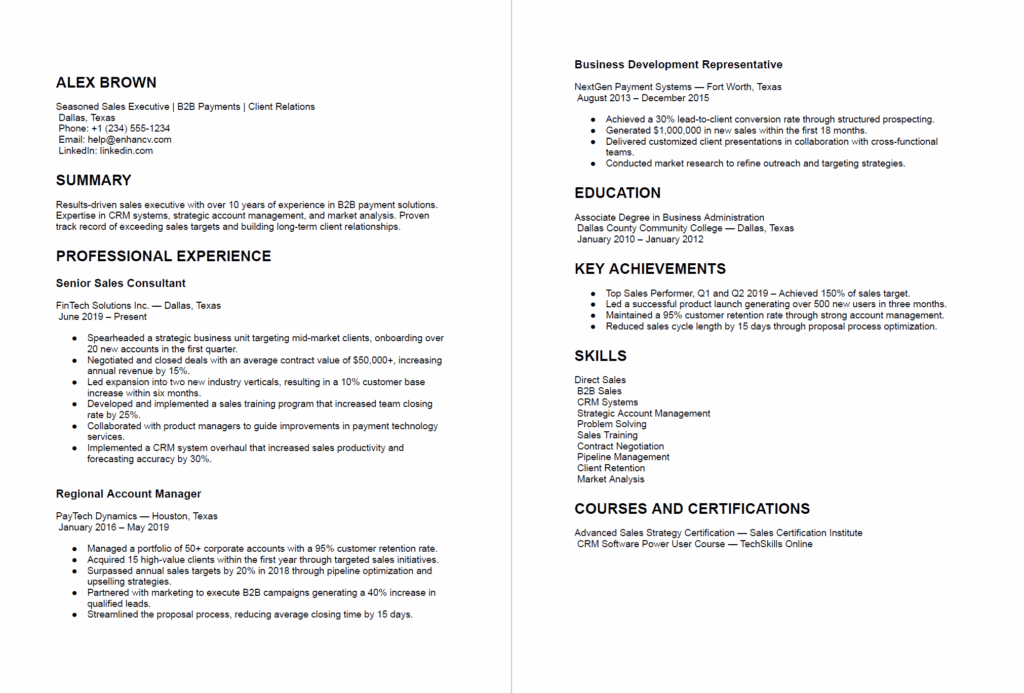
Final Checklist Before Submitting Your Sales Resume
Once you’ve worked through your new resume, you will want to conduct a final inspection. One mistake – a typo, a error in formatting, or even leaving off a relevant metric can quickly throw your resume into the circular file. So anyhow, before you hit send, conduct a rigorous ‘Resume Checklist.’
- Use the Proofreading Power Scan: How does it work? Read your resume backwards. Why? It will force your brain to focus on each individual word and help catch mistakes that you might have missed otherwise as part of your normal reading pattern.
- The ATS Test: If you have access to a Resume Checker or scoring tool, run it through that to validate keyword density and detect any error in formatting that might impact the readability.
- The Quantifier Check: Verify that every bullet point in “Professional Experience” has at least 1 number, percentage, or dollar amount in it. If it does not, go back to your bullet and revise it, until it does.
- Contact Clarity: Make sure your name, phone number, professional email and (especially for sales purposes), your LinkedIn profile link, are accurate, current, and professional.
- Job Tailoring: Confirm that your summary and the first 3-5 bullet points in your experience section address the most significant responsibilities, requirements, or qualifications provided in that particular job posting.
This last step of quality control will ensure that your resume perfectly mirrors the high level of professionalism and attention to detail that is necessary for a position in sales of any kind.
Conclusion: Developing a results-oriented professional sales resume
Developing a results-oriented professional sales resume requires strategy and precision with an unwavering focus on measurable change. You need to think of your document you may not think of it as a record of what you have done, but rather a proposal of what you bring to the table going forward.
Thinking that your resume is a proposal will help you adopt techniques such as the CAR method, incorporating high-impact keywords, using the MagicalAPI Resume Score and a proofreading process, to move you from just an applicant to a measurable outcome. If you demonstrate your Proven Revenue Growth Record, you will successfully convey your value into the career position that alters your future.
FAQs about sales resume
1. How far back in my work history should my sales resume go?
In general, the last 10 to 15 years is enough for the vast majority of professionals. If you have job history that is older and is very relevant for the role, it is acceptable to be brief and summarize that work experience. However, stick to detailed, quantified bullet points for your more recent work history where you have had the greatest experience and impact.
2. Can I use graphics or color in my sales resume to make it stand out?
For most job applications submitted through online applications, no. Most ATS systems are not able to parse graphically complex designs into readable information and can have your data all scrambled or disappeared. Keep the sales resume clean, black and white, and professional. There are some limited bolding and capitalization for emphasis, but should not be over-used.
3. What if I haven’t met quota in a prior role?
Emphasize the good things about the role…. pipeline generated, volume of clients brought on, process improvements, etc. For example, instead of talking about quota, you could share: “Built and managed a $2M+ pipeline of qualified leads in a new territory, setting up the territory for a 20% increase in revenue in the following quarter.” Be honest, but emphasize results that reflect your skill and efforts.
4. Should I include a list of references?
No. The phrase “References available upon request” is outdated and serves no purpose. Recruiters will assume you have references. Only share reference information when it is requested specifically later in the hiring process.


